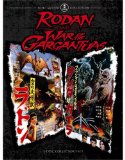| Reviews & Columns |
|
Reviews DVD TV on DVD Blu-ray 4K UHD International DVDs In Theaters Reviews by Studio Video Games Features Collector Series DVDs Easter Egg Database Interviews DVD Talk Radio Feature Articles Columns Anime Talk DVD Savant Horror DVDs The M.O.D. Squad Art House HD Talk Silent DVD
|
DVD Talk Forum |
|
|
| Resources |
|
DVD Price Search Customer Service #'s RCE Info Links |
|
Columns
|
|
|
Rodan and War of the Gargantuas (Toho Master Collection)
As part of their Toho Master Collection, Toho and Sony Classic Media have released a slam-bang, action-filled daikaiju eiga double feature with Rodan and War of the Gargantuas, including not only the English-dubbed versions of these films we all grew up on, but also the original uncut Japanese language versions (with English subtitles), as well. Extras (or more accurately, "extra" as in a single one) are skimpy, but fans of the genre can't go wrong in picking up this nice double-header of building-smashing, tank-stomping, people-chomping, kaiju fun. Since most of us are more familiar with the English language versions of Sora no Daikaiju Radon and Furankenshutain no Kaiju: Sanda tai Gaira, I'll use those versions for the synopsizes (with more detailed discussion of both the Japanese and English-language comparisons - the screen caps are English language first, followed by the original Japanese transfer).
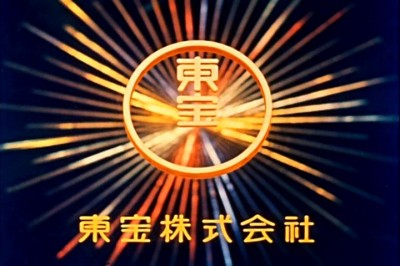
RODAN
An opening montage of newsreel footage discusses the destructive power of the atom bomb while a narrator wonders what effects radiation might be having on "Mother Earth," and what the "aftermath" of those effects might be. In a picturesque mining town at the foothills of the Mt. Aso volcano, in the southern-most island provinces, we soon find out. Shigeru Kawamura (Kenji Sahara), a colliery engineer, is disturbed to find that mine shaft #8's floor is creeping and taking on water. Even more unsettling, a miner has been savagely killed, and many of the nervous miners believe it's Goro (Rinsaku Ogata), the older brother of Kiyo (Yumi Shirakawa), who is Shigeru's girlfriend. When other miners begin to die, and Goro disappears, the villagers begin to turn against Kiyo - until a giant "meganula" (think a vicious 16-foot Doodlebug) attacks Kiyo's house. Tracing the meganula back to the mine shaft, Shigeru is feared dead when Japanese Self-Defense Forces attack the meganula, with a resulting earthquake leveling the mining area.
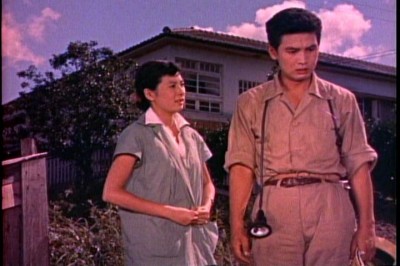
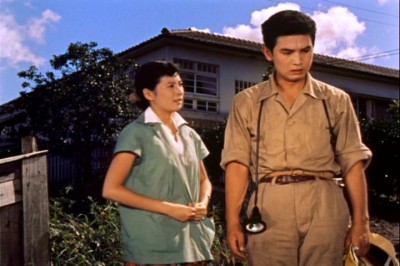
However, Shigeru is later found wandering around the colliery wasteland. He has amnesia, but quickly recovers, and describes his visit to a vast underground cave, where the meganula tended two giant eggs. One of the eggs hatched, and Shigeru witnessed the birth of Rodan, a pteranondon-like creature who has been in hibernation for millions of years. Soon, reports come in of an unidentified flying object, capable of incredible supersonic speeds and impossible maneuverings, wiping out a jet fighter. And later, some camera film found laying by a volcano, taken by a honeymooning couple who were killed by Rodan, is developed, confirming Shigeru's story. Within hours, nearby city Sasebo (Fukuoka in the original Japanese version) is besieged by not one but two gigantic Rodans.
SPOILERS ALERT!
Rodan was always a particular favorite of ours whenever our local TV stations ran their traditional bi-annual Godzilla film festivals on the afternoon Dialing for Dollars show, or when it appeared countless times on the late, late program. I guess it worked well on TV back then because, unlike its earlier two Godzilla predecessors, it was in color, and unlike its later successors, it was shot in the old Academy ratio (or close to it at 1.37:1), so it was almost perfectly framed on the TV. If pushed, we may have stated a preference for Ghidrah, the Three-Headed Monster or indeed, War of the Gargantuas, but you could never really tell what the hell was going on in those cropped, pan-and-scanned versions on our TV set. Rodan carnage, still looking quite good even today, fit the TV perfectly.
Watching Rodan now, and comparing it to the uncut Japanese version (a first for me with this title), I have to say I enjoyed it even more, appreciating the suspense aspects of the first segment of the film, as much as the smartly choreographed mayhem of the second. Of course, that appreciation is amplified particularly with the Japanese version included here (some of which might be due to the much-improved print Toho has provided). Gone is the narration found on the English-language version, as well as all the references to American involvement in the story. And while I still do enjoy certain aspects of the English-language version (the setting up of the miners as nervous and edgy for some unknown, almost supernatural reason; the final poetic words of the narrator describing the Rodans "welcoming the agonies of death"), the Japanese version strikes be as much more gritty, much more of a traditional suspense tale (until the monster is made known) that segues more cleanly into the Rodans' final destruction of the city. I was particularly pleased to see the miner talk like real miners (uttering vulgarities translated in the subtitles), while the film itself, running ten minutes longer than the English-language version, seemed tighter and better paced than the shorter version I'm familiar with (no doubt because quite a few scenes, especially with the miners, are now in the correct order - there's some significant shuffling of those scenes in the English-language version).
Leaving that all aside, though, it's the mayhem that ultimately counts with these tokusatsu/daikaiju eiga films, and the final winged assaults by the Rodans are still pretty cool (the model work is still first-rate). I know today's elaborate special effects supposedly beats this "primitive" puppetry, model work and "a-guy-in-a-rubber-suit" technology to death, but watching this with my younger boys (who have seen all the latest CGI-crammed efforts), they seemed delighted with the results. And as I've written before about these films, that very nature of the "toy-like" quality of the Toho special effects from this period makes the films inordinately attractive to young kids. They see it for exactly what it is: these are toys; these are models. And they're getting smashed to bits (just like they smash up their own toys). There's no façade of pseudo-realism, like the CGI efforts today that try so strenuously to slavishly imitate reality (even if the Japanese special effects men were trying for heightened realism). These films are "play" to younger audiences, fairy tales that are scary and yet oddly reassuring because after all, they're just guys jumping up and down on toys. War of the Gargantuas will mine this child-like fairy tale destruction with epic results.
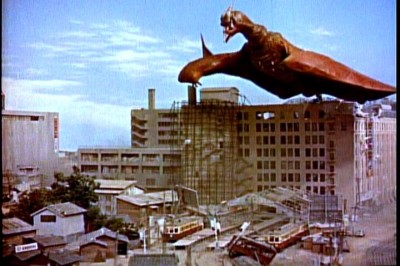
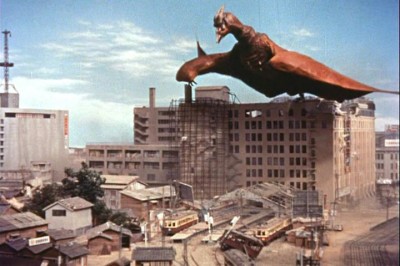
WAR OF THE GARGANTUAS
Technically not really a sequel to the previous Toho effort, 1965's Frankenstein Conquers the World (Frankenstein Tai Chitei Kaiju), War of the Gargantuas obliquely implies that cells, torn away from the Frankenstein monster that battled Baragon in the prior film, have now mutated into two cloned "brothers." Sanda, the placid brown-colored gargantua who lives in the mountainous forests, was raised in captivity by Akemi (Kumi Mizuno), a gorgeous scientist who works with fellow researchers Dr. Paul Stewart (Russ Tamblyn) and Dr. Yuzo Majida (Kenji Sahara). However, it's Gaira, the violent green gargantua who lives in the sea, that first captures the attention of the public, the scientists and the military. After a lone fisherman describes his ordeal when Gaira destroyed his boat and ate his crew, the authorities, specifically the Japanese Defense Forces, as well as the media, believe that Sanda is responsible. Akemi, who remembers Sanda's tender heart, can't believe that her gentle little Frankenstein freak would kill without conscience, and neither do Paul or Yuzo, but when Gaira attacks again, this time, among other things, attacking the airport and eating a woman, the scientists' pleas for mercy fall on deaf ears.
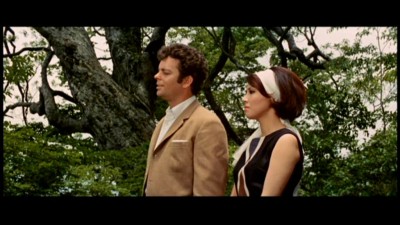
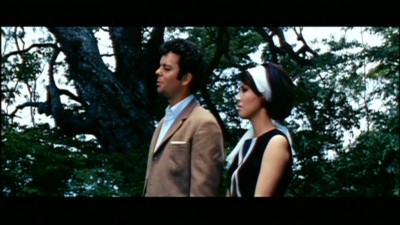
The JDF, armed with newly developed maser weapons, set a trap for the gargantuan, electrifying a lake, as well, to bring down the monster. Unfortunately for the military, though, Garia's "brother," Sanda, appears, and rescues the severely wounded monster. The scientists, vindicated in their belief that two monsters do exist, and that Sanda wasn't responsible for the earlier mayhem, still can't convince the authorities to treat the monsters separately (even the U.N. is consulted, but after 107 paper resolutions and eight years of talk....). As the gentle Sanda tries in vain to calm the berserk Gaira (to no avail), the order goes down to the JDF: destroy both monsters. As Gaira goes on his final rampage, leveling an entire city, Sanda makes one last effort to stop him in a deadly battle royale.
SPOILERS ALERT!
I'm probably not alone in believing that War of the Gargantuas was a particular Toho TV favorite for kids of the 70s, where it played endlessly on Saturday afternoon and midnight "horror host" shows. In my part of the country, Lawson Deming's Sir Graves Ghastly out of Detroit ruled Saturday afternoons, and Rod Sweed's The Ghoul ("Stay sick, turn blue!") ruled the night (on WKBD-Channel 50) - and one of his most requested titles to show was War of the Gargantuas. It was the perfect kind of title for his zero-budget show for many reasons, most notably for War's almost total lack of a story (leaving Sweed plenty of room to improvise dubbed-in sound effects and other voice-over gags and inserted skits), and for its non-stop miniature mayhem. Sweed, as fans will no doubt remember, loved to blow things up with firecrackers - big firecrackers - and War of the Gargantuas's constant action footage suited his "destroy anything for a laugh" mentality to a "T" (Froggy's "hiya, hiya, hiya!" in particular was stomped often during any given War of the Gargantuas presentation).
Of course, watching War of the Gargantuas is an entirely different experience today, one of nostalgia, really, more than anything else (when I was a kid, it wasn't the green versus the brown one, but the gray versus the grayer one on my black and white set). Admittedly, it's not as much fun without the studio breaks for fireworks destruction, but it's nice to finally see the entire widescreen image - the old pan-and-scan frequently didn't make much sense, with the action scenes barely comprehensible as to who was smashing whom. My young boys respected the amount of miniature destruction that went into the film (my youngest immediately asked if we could get the "toys" for the film at McDonald's - always a good sign), and again, for my money, War of the Gargantuas has the best model work of all the classic Toho kaiju features from the 1960s. It's obvious that an incredible amount of time went into painstakingly recreating huge urban landscapes, complete down to the smallest detail...all for a five second shot of one of the gargantuas spectacularly smashing into it. It's just a shame that one-tenth of that effort wasn't put into the frequently silly script.
No one ever asked the classic Toho monster films not to be silly; after all, that's part of the evergreen charm of many of them. But the script for War of the Gargantuas is the flimsiest of skeletons on which to hang the frequent special effects battles - which is good news for kids who are looking for non-stop action, but...well...not "bad news," but certainly "fair-to-middling news" for adults who may be watching this alone without the benefit of enjoying it again through the eyes of a screaming, hopped-up kid. It's just that so much of War of the Gargantuas makes little to no sense, that all we're left with is the experience of staring at the various attacks of the gargantua, and even that wears thin after awhile (god, please stop that "Chert! Chert!" of the green one). Lead (in the American version) Russ Tamblyn looks not embarrassed, not contemptuous, not vacant, but stoned out of his gourd half the time, with little to do in the film but to try to fob off horrid one-liners (it's a toss-up between "Maybe he fell in love with a whale," and "Remember, he's not a toy poodle" for all-time groaners), or chase nonsensically after the beauty Mizuno (director Ishiro Honda had to have other things on his mind when he shot the luminous Mizuno, sweat glistening on her as she hangs over a cliff, her face an erotic mask beneath her quiet sighs and moans).
There are whoppers galore in War of the Gargantuas. Why does Akemi run towards the big mean gargantua down in the subway, instead of away from him? While the others are appropriately attired for their mountain hike, why is Tamblyn suited up in one of Jerry Lewis' Sy Devore leftovers? Why doesn't the military let the nice big brown one fight the bad green one without trying to kill them both (one of my favorite moments occurs when one of soldiers phones headquarters and says, "We've sighted him!" And I ask, after seeing the thing tower over the trees, "Who didn't sight him?")? Couldn't I have had even the most basic explanation as to how "protein-rich plankton in the sea grew the Frankenstein cells" into a gigantic walking, cherting block-buster? All of which, one might rightfully say, is nitpicking. The original Japanese version clears up some of the puzzlers that didn't make sense before (for example, in the original, Tamblyn gets the idea that there are two monsters earlier than in the U.S. version, eliminating the confusion over his surprise when indeed two gargantuas appear), while thankfully relegating Tamblyn to the background, but it's not much better in the logic department. So, despite seeing the film "correctly" for the first time (in its proper ratio with the option to watch the more - barely - comprehensive Japanese version), I couldn't help but wish it was interrupted every now and then by a couple of commercial breaks (Detroit's Mr. Belvedere intoning, "We...do...good...work!" for his construction company would do nicely) and someone sticking a firecracker in a rubber frog's mouth and blasting away. That may be the only true, proper way to view War of the Gargantuas.
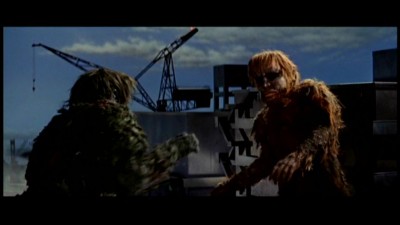
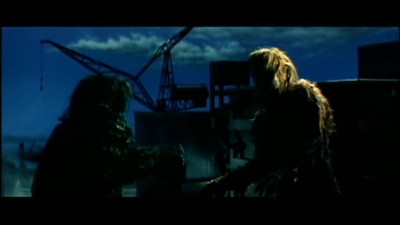
The DVD:
The Video:
As previously stated, this Toho Master Collection two-disc set offers both the original Japanese version and the U.S. release/TV version of Rodan and War of the Gargantuas. The Japanese version of Rodan is a revelation. The full-screen, 1.33:1 transfer sports a beautifully-valued color print, largely free of scratches and dirt, with deep blacks and impressive clarity (the U.S. version, by comparison, looks like a snowstorm of scratches at times, along with pinkish, faded color, and a fuzzy image). War of the Gargantuas, in the Japanese version, looks a tad dark to me (with some of the fine detail lost during the final nighttime urban battle), as well as a slightly fuzzy picture (and a slight anamorphic squeeze, to my eye). The American version is certainly brighter (at times, almost blown out with contrast), but you can see the model work more closely, and it's a sharper image...so, it's a toss-up between the two for this title. Compression issues did appear, with some noise reduction efforts and edge enhancement at times marring the image.
The Audio:
The Dolby Digital English and Japanese 2.0 stereo mix often times just sounds like split mono, with very few directional effects. The levels are loud, though, and that's a plus during the destruction. Dialogue is cleanly rendered. English subtitles are available for the Japanese versions.
The Extras:
The most glaring omission as far as extras go for the Rodan and War of the Gargantuas double disc are no commentaries by DVDTalk's own Stuart Galbraith IV, an internationally-acknowledged expert on Toho kaiju films. After his stand-out performance on Classic Media's Monster Zero disc release, I was disappointed not to hear any possible explanations for what the hell might be going on in War of the Gargantuas. There is a very interesting documentary, though, Bringing Godzilla Down to Size, that features interviews with many celebrated Toho masters of the genre, discussing the importance of their work. It's a great bonus if you're new to the subject.
Final Thoughts:
Rodan and War of the Gargantuas, from the Toho Master Collection series from Sony's Classic Media, is a colorful, action-filled daikaiju eiga double feature that should please kaiju fans enormously with its alternate Japanese-language versions and its fairly good prints (although compression issues do take that down a notch, and there could have been more extras). I recommend Rodan and War of the Gargantuas.
Paul Mavis is an internationally published film and television historian, a member of the Online Film Critics Society, and the author of The Espionage Filmography.
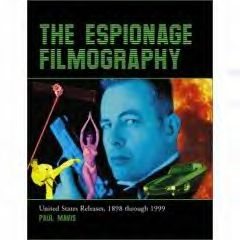

|
| Popular Reviews |
| Sponsored Links |
|
|
| Sponsored Links |
|
|
| Release List | Reviews | Shop | Newsletter | Forum | DVD Giveaways | Blu-Ray | Advertise |
|
Copyright 2024 DVDTalk.com All Rights Reserved. Legal Info, Privacy Policy, Terms of Use,
Manage Preferences,
Your Privacy Choices | |||||||









